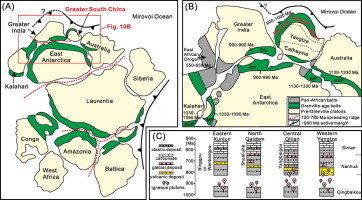当前位置:
X-MOL 学术
›
Gondwana Res.
›
论文详情
Our official English website, www.x-mol.net, welcomes your
feedback! (Note: you will need to create a separate account there.)
Formation and evolution of the Eastern Kunlun Range, northern Tibet: Evidence from detrital zircon U-Pb geochronology and Hf isotopes
Gondwana Research ( IF 7.2 ) Pub Date : 2020-07-01 , DOI: 10.1016/j.gr.2020.01.015 Xing Jian , Amy Weislogel , Alex Pullen , Fei Shang
Gondwana Research ( IF 7.2 ) Pub Date : 2020-07-01 , DOI: 10.1016/j.gr.2020.01.015 Xing Jian , Amy Weislogel , Alex Pullen , Fei Shang

|
Abstract The Eastern Kunlun Range, as a high-elevation and granitoid-rich tectonic element in northern Tibet, records Paleozoic–Mesozoic amalgamation process of the East Asia continent and Cenozoic uplift of the Tibetan Plateau. However, Precambrian evolution of the Eastern Kunlun remains poorly understood and relations between Eastern Kunlun and adjacent terranes (e.g., Qaidam and Qilian) during the Phanerozoic accretion process are still highly controversial. We use detrital zircon U-Pb geochronological and Hf isotopic data of Proterozoic and Paleozoic metasedimentary rocks from the Eastern Kunlun Range, to reconstruct its origin and subsequent evolutionary history. Detrital zircons of the Proterozoic rocks are dominated by early–middle Neoproterozoic ages (700–1000 Ma), with two age peaks at ca. 800 Ma and ca. 920 Ma and eHf(t) values ranging from −10 to 5. The youngest detrital zircon ages (648–788 Ma) demonstrate that these investigated Proterozoic strata, which were previously mapped as Paleoproterozoic to Mesoproterozoic, were most likely deposited in the middle–late Neoproterozoic. Abundant 0.9–1.0 Ga detrital zircon crystals are consistent with those crystalline rocks of similar ages across the Kunlun-Qaidam and Qilian terranes, which are generally interpreted as the product of Grenvillian orogenesis. These findings support the hypothesis that these terranes were probably within a single continental landmass (named as KQQ block) during the Neoproterozoic. The high similarity of detrital zircon ages, Hf isotopes and Neoproterozoic lithostratigraphy between western Yangtze and KQQ blocks, supports a temporary connection of the KQQ block to western Yangtze in Rodinia supercontinent. Detrital zircons of the analyzed Paleozoic rocks are characterized by 390–490 Ma age populations. These results, in combination with published granitoids data of the northern Tibet, favor a scenario in which the Kunlun-Qaidam and Qilian terranes underwent separated subduction and accretion processes during the late Cambrian–Devonian, but together formed an upper plate to northward subduction of the Paleo-Tethys during the Permian–Triassic.
中文翻译:

藏北东昆仑山脉的形成与演化:来自碎屑锆石U-Pb年代学和Hf同位素的证据
摘要 东昆仑山脉作为藏北高海拔、富含花岗岩的构造元素,记录了东亚大陆古生代-中生代合并过程和青藏高原新生代隆升。然而,东昆仑的前寒武纪演化仍知之甚少,在显生宙增生过程中,东昆仑与邻近地体(如柴达木和祁连)之间的关系仍然存在很大争议。我们利用东昆仑山脉元古界和古生界变沉积岩的碎屑锆石 U-Pb 年代学和 Hf 同位素数据,重建其起源和随后的演化历史。元古代岩石的碎屑锆石以早-中新元古代(700-1000 Ma)为主,在约 2 处有两个年龄峰。800 马和约。920 Ma 和 eHf(t) 值范围从 -10 到 5。最年轻的碎屑锆石年龄(648-788 Ma)表明这些调查的元古代地层,以前被绘制为古元古代到中元古代,最有可能沉积在中-新元古代晚期。丰富的 0.9-1.0 Ga 碎屑锆石晶体与昆仑-柴达木和祁连地体的相似年龄结晶岩一致,通常被解释为格伦维尔造山作用的产物。这些发现支持了这样的假设,即这些地体可能在新元古代期间位于单个大陆陆块(称为 KQQ 地块)内。扬子西部与KQQ地块碎屑锆石年龄、Hf同位素和新元古代岩石地层学高度相似,支持将 KQQ 区块临时连接到罗迪尼亚超大陆的长江西部。分析过的古生代岩石碎屑锆石以 390-490 Ma 年龄群为特征。这些结果与已发表的藏北花岗岩数据相结合,有利于昆仑-柴达木和祁连地体在晚寒武世-泥盆世期间经历了独立的俯冲和增生过程,但共同形成了一个上板块向北俯冲的情景。二叠纪-三叠纪时期的古特提斯纪。
更新日期:2020-07-01
中文翻译:

藏北东昆仑山脉的形成与演化:来自碎屑锆石U-Pb年代学和Hf同位素的证据
摘要 东昆仑山脉作为藏北高海拔、富含花岗岩的构造元素,记录了东亚大陆古生代-中生代合并过程和青藏高原新生代隆升。然而,东昆仑的前寒武纪演化仍知之甚少,在显生宙增生过程中,东昆仑与邻近地体(如柴达木和祁连)之间的关系仍然存在很大争议。我们利用东昆仑山脉元古界和古生界变沉积岩的碎屑锆石 U-Pb 年代学和 Hf 同位素数据,重建其起源和随后的演化历史。元古代岩石的碎屑锆石以早-中新元古代(700-1000 Ma)为主,在约 2 处有两个年龄峰。800 马和约。920 Ma 和 eHf(t) 值范围从 -10 到 5。最年轻的碎屑锆石年龄(648-788 Ma)表明这些调查的元古代地层,以前被绘制为古元古代到中元古代,最有可能沉积在中-新元古代晚期。丰富的 0.9-1.0 Ga 碎屑锆石晶体与昆仑-柴达木和祁连地体的相似年龄结晶岩一致,通常被解释为格伦维尔造山作用的产物。这些发现支持了这样的假设,即这些地体可能在新元古代期间位于单个大陆陆块(称为 KQQ 地块)内。扬子西部与KQQ地块碎屑锆石年龄、Hf同位素和新元古代岩石地层学高度相似,支持将 KQQ 区块临时连接到罗迪尼亚超大陆的长江西部。分析过的古生代岩石碎屑锆石以 390-490 Ma 年龄群为特征。这些结果与已发表的藏北花岗岩数据相结合,有利于昆仑-柴达木和祁连地体在晚寒武世-泥盆世期间经历了独立的俯冲和增生过程,但共同形成了一个上板块向北俯冲的情景。二叠纪-三叠纪时期的古特提斯纪。











































 京公网安备 11010802027423号
京公网安备 11010802027423号